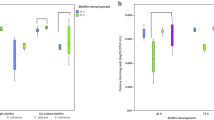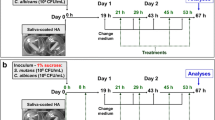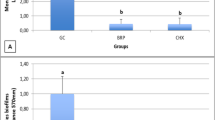Abstract
The biofilm formation of the oral fungal pathogen Candida on denture acrylic strips coated with saliva or serum was examined in relation to the ability to induce hyphae by thigmotropic reaction, using C. albicans (4 isolates), C. glabrata (3 isolates) and C. tropicalis (3 isolates). Both the degree of biofilm formation and the amount of hyphae exhibiting thigmotropism varied depending upon both the species and strains of Candida. Although there was no significant correlation between the amount of hyphae induced by thigmotropic reaction of fungal isolates and biofilm formation on uncoated control specimens (r = 0.577; p < 0.05), the ability of hyphae induced by thigmotropic reaction significantly correlated with the amount of both saliva- and serum-admixed biofilms (r = 0.734; p < 0.05 and r = 0.793; p < 0.01, respectively). Taken together our in vitro data suggested that the hyphal induction by thigmotropic reaction is of importance in candidal biofilm formation on saliva- or serum-coated acrylic surfaces.
Similar content being viewed by others
References
Berlutti LS, Passariello C, Comodi-Ballanti MR, Thaller MC. Proteolytic enzymes: A new treatment strategy for prosthetic infections? Antimicrob Agents Chemother 1993; 37: 2618‐2621.
Bouali A, Robert R, Tronchin G, Senet J-M. Binding of human fibrinogen to Candida albicans in vitro: A preliminary study. J Med Vet Mycol 1986; 24: 345‐348.
Budtz-Jorgensen E. The significance of Candida albicans in denture stomatitis. Scan J Dent Res (Eur J Cell Sci) 1974; 82: 151‐190.
Budtz-Jorgensen E. Candida-associated denture stomatitis and angular cheilitis. In: Samaranayake LP, MacFarlane TW, eds. Oral Candidosis. London: Wright, 1990: 156‐183.
Bull FG, Turner NR. A serum mannan-binding protein and candidiasis. Sabouraudia (J Med Vet Mycol) 1984; 22: 347‐350.
Cannon RD, Nand AK, Jenkinson HF. Adherence of Candida albicans to human salivary components adsorbed to hydroxylapatite. Microbiol (UK), 1995; 141: 213‐219.
Critchley IA, Douglas LJ. Differential adhesion of pathogenic Candida species to epithelial cells and inert surfaces. Fems Microbiol Lett 1985; 28: 199‐203.
Davenport JC. The oral distribution of Candida in denture stomatitis. Br Dent J 1970; 129: 151‐156.
Edgerton M, Scannapieco FA, Reddy MS, Levine MJ. Human submandibular-sublingual saliva promotes adhesion of Candida albicans to polymethylmethacrylate. Infect Immun 1993; 61: 2644‐2652.
Farber BF, Wolff AG. Salicylic acid prevents the adherence of bacteria and yeast to silastic catheters. J Biomed Mater Res 1993; 27: 599‐602.
Gow NAR, Perera THS, Sherwood-Higham J, Gooday GW, Gregory DW, Marshall D. Investigation of touch-sensitive responses by hyphae of the human paththogenic fungus Candida albicans. Scanning Microsc 1994; 8: 705‐710.
Hawser SP, Douglas LJ. Biofilm formation by Candida species on the surface of catheter materials in vitro. Infect Immun 1994; 62: 916‐921.
Kennedy MJ. Methods for studying the role of fungal attachment in colonization and pathogenesis. Mycopathologia 1990; 109: 123‐137.
Kricka LJ. Clinical and biochemical application of luciferases and luciferins. Anal Biochem 1988; 175: 14‐21.
McCourtie J, Douglas LJ. Relationship between cell surface composition of Candida albicans and adherence to acrylic after growth on different carbon sources. Infect Immun 1981; 32: 1234‐1241.
McCourtie J, Douglas LJ. Relationship between cell surface composition, adherence, and virulence of Candida albicans. Infect Immun 1984; 45: 6‐12.
Minagi S, Miyake Y, Inagaki K, Tsuru H, Suginaka H. Hydrophobic interaction in Candida albicans and Candida tropicalis adherence to various denture base resin materials. Infect Immun 1985; 47; 11‐14.
Nikawa H, Hayashi S, Nikawa Y, Hamada T, Samaranayake LP. Interactions between denture lining material, protein pellicles and Candida albicans. Arch Oral Biol 1993; 38: 631‐634.
Nikawa H, Nishimura H, Yamamoto T, Samaranayake LP. A novel method to study the hyphal phase of Candida albicans and to evaluate its hydrophobicity. Oral Microbiol Immun 1995; 10: 110‐114.
Nikawa H, Nishimura H, Yamamoto T, Hamada T, Samaranayake LP. The role of salivary or serum pellicle in the colonization process of Candida albicans on denture acrylic in vitro. Microb Ecol Health Dis 1996; 9: 35‐48.
Nikawa, H., Nishimura, H., Hamada, T. and Sadamori, S. Quantification of thigmotropism (contact sensing) of Candida albicans and Candid tropicalis. Mycopathologia 1997; 138: 13‐19.
Rotrosen D, Calderone RA, Edwards Jr JE. Adherence of Candida species to host tissues and plastic surfaces. Rev Infect Dis 1986; 8: 73‐85.
Samaranayake LP, MacFarlane TW. An in vitro study of the adherence of Candida albicans to acrylic surfaces. Arch Oral Biol 1980; 25: 603‐609.
Samaranayake LP, McCourtie J, MacFarlane TW. Factors affecting the in vitro adherence of Candida albicans to acrylic surfaces. Arch Oral Biol 1980; 25: 603‐609.
Sherwood J, Gow NAR, Gooday GW, Gregory DW, Marshall D. Contact sensing in Candida albicans: a possible aid to epithelial penetration. J Med Vet Mycol 1992; 30: 461‐469.
Silverman Jr S, Migliorati CA, Epstein JB, Samaranayake LP. Laboratory diagnosis of oral candidosis. In: Samaranayake LP, MacFarlane TW, eds. Oral Candidosis. London: Wright, 1990: 213‐237.
Siro RM, Romar H, Lovgren T. Continuous flow method for extraction and bioluminescence assay of ATP in baker's yeast. Eur J Appl Microb Biotechnol 1982; 15: 258‐264.
Vasilas A, Molina L, Hoffman M, Haidaris CG. The influence of morphological variation on Candida albicans adhesion to denture acrylic in vitro. Arch OraI Biol 1992; 37: 613‐622.
Rights and permissions
About this article
Cite this article
Martinez, R. Relationship between thigmotropism and Candida biofilm formation in vitro. Mycopathologia 144, 125–129 (1998). https://doi.org/10.1023/A:1007073930933
Issue Date:
DOI: https://doi.org/10.1023/A:1007073930933




